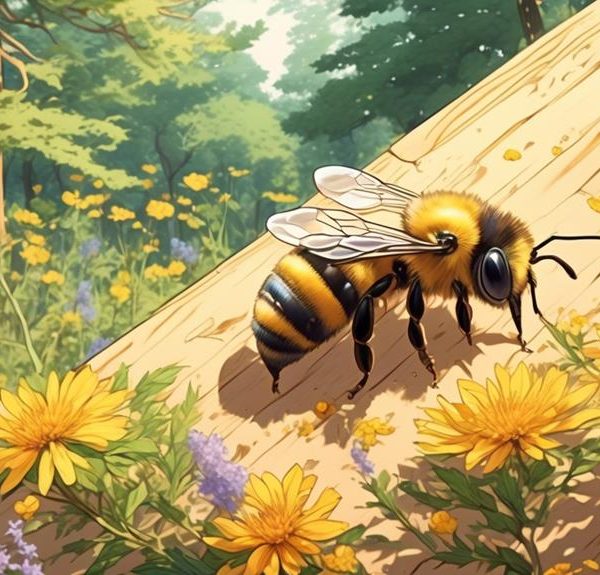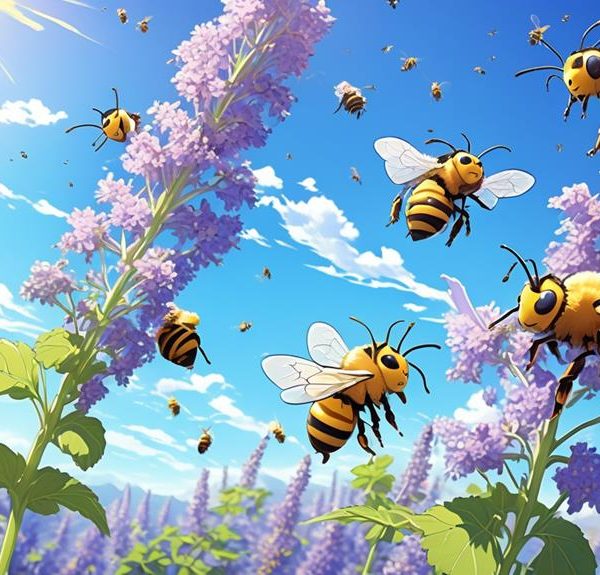Dive into the fascinating world of bees and iris flowers, exploring the complex interplay that shapes nature's delicate balance.
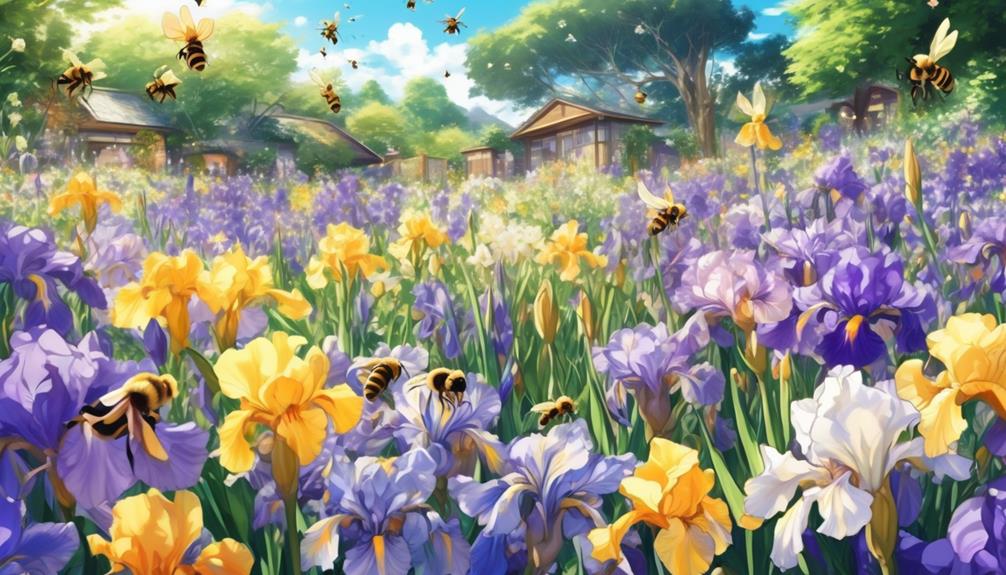
Do Bees Like Iris?
In the vast world of flora, where the subtle fragrance of roses dances with the intoxicating scent of jasmine, do you ever wonder if bees have a preference, particularly for the elegant iris?
You've likely seen these buzzing workers busily darting from one bloom to another, their tiny bodies dusted with pollen. But what draws them to the iris, or does it at all?
As you lean into this intriguing intersection of botany and entomology, you'll discover the complex interplay between bees and iris flowers, revealing more about nature's delicate balance.
Stick around and you might find yourself viewing your garden through a whole new lens.
Key Takeaways
- Bees are attracted to iris flowers due to their scent, color, and structure.
- Iris flowers provide bees with nectar and pollen, essential for their survival and reproduction.
- The interaction between bees and iris flowers is mutually beneficial and contributes to biodiversity.
- Conservation of iris populations and creating bee-friendly environments are important for maintaining healthy bee populations and ecosystem balance.
Understanding Bees and Their Preferences
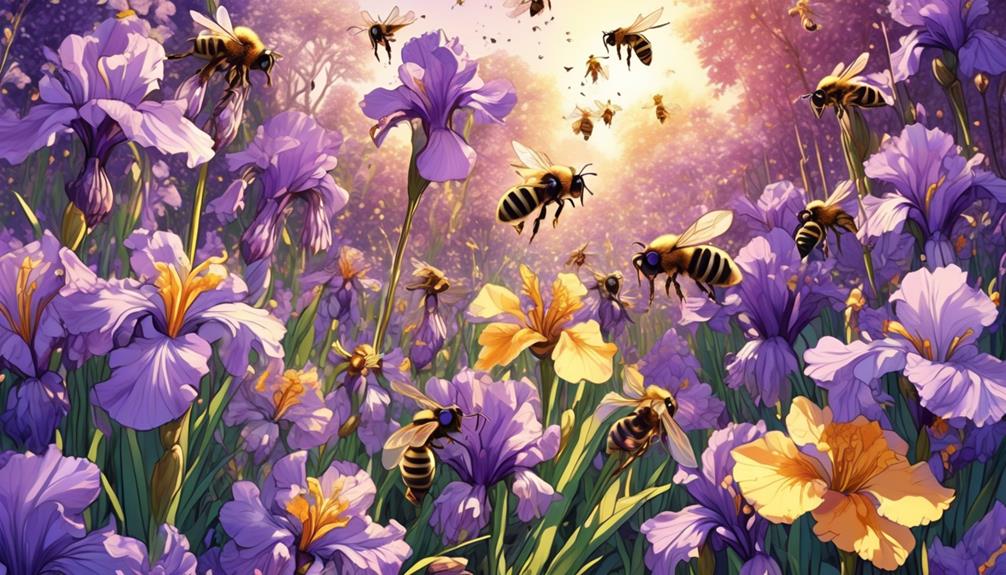
To fully comprehend why bees may favor certain flowers, such as the iris, it's essential to delve into their unique biology and behavioral patterns. Bees are no ordinary insects; they're equipped with an advanced olfactory system that allows them to detect and discern a wide array of floral scents. This, combined with their color vision, guides them to flowers that offer the most nectar and pollen.
When you look at an iris flower, you'll notice it's not just aesthetically pleasing to humans, but to bees as well. Its vivid colors and distinct scent are like a beacon, drawing in bees from all around. Additionally, the shape and structure of an iris flower facilitate easy access to nectar, enticing bees even further.
However, it's not all about the bees. Iris plants, like other flowers, depend on these pollinators for reproduction. They've evolved over time to attract bees, developing characteristics that appeal to these insects. The iris's strong scent, vibrant color, and convenient structure are all part of a complex biological strategy to ensure its survival and propagation.
Understanding this symbiotic relationship deepens our appreciation of the intricate interplay between bees and irises.
The Allure of Iris Flowers
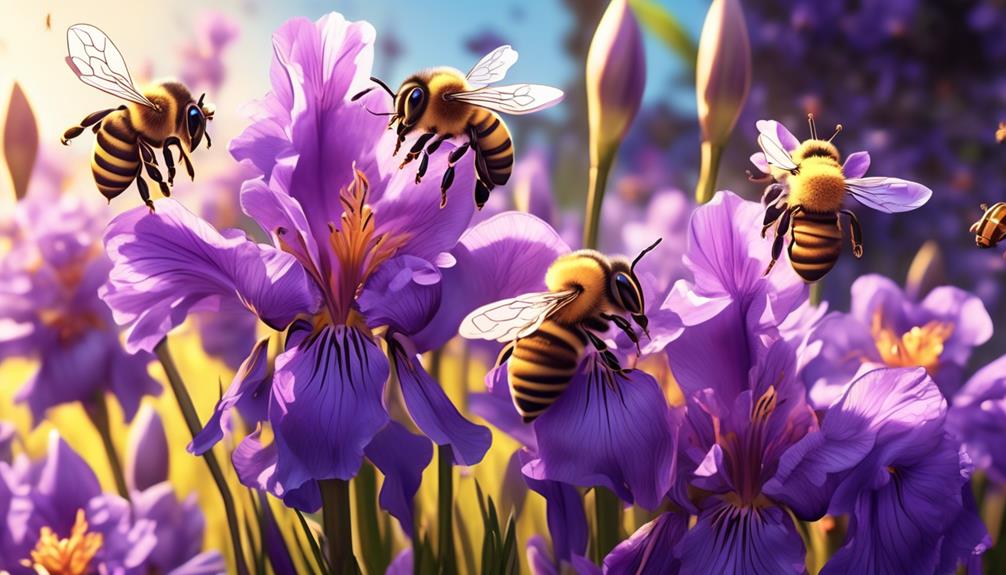
Diving into the allure of iris flowers, you'll quickly notice three key features that make them irresistible to bees: their strong fragrance, their vibrant colors, and their unique structure.
The strong fragrance of iris flowers, often described as sweet or spicy, is a powerful attractant for bees. This scent, detectable even at a distance, acts as a beacon, guiding bees towards the source of potential nectar.
Next, the vibrant colors of iris flowers, primarily blues and purples, are known to be particularly attractive to bees. Bees perceive color differently from humans, being more sensitive to ultraviolet light. The intense coloration of iris flowers provides a visual cue that signals a rich food source.
Lastly, the unique structure of an iris flower facilitates easy access to nectar for bees. The large, flat petals act as a landing platform, while the flower's design guides the bee towards the nectar, pollen, and reproductive organs, aiding in pollination.
In essence, iris flowers have evolved to be not only visually appealing but also a strategic lure for bees, enhancing their chances of cross-pollination. Their allure lies in the perfect blend of fragrance, color, and structure, designed to entice their preferred pollinators.
Iris: A Source of Nectar and Pollen
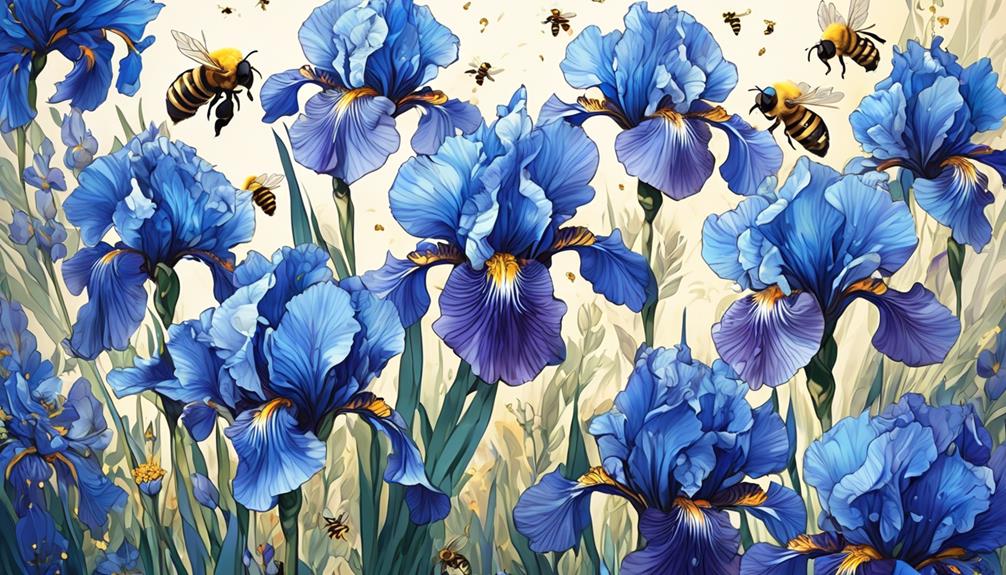
Beyond their captivating allure, iris flowers serve as a vital source of nectar and pollen for bees, providing essential nutrients that sustain their health and productivity.
You see, nectar, a sweet fluid secreted by the iris, is packed with sugars that bees transform into energy-rich honey. It's the bee's primary source of carbohydrates, driving their flight muscles and metabolism.
On the other hand, the pollen, often overlooked, is equally crucial. It's the bee's primary protein source, fundamental for bee larvae's growth and development. When bees forage on iris flowers, they inadvertently collect pollen grains on their hairy bodies. Then, as they move from flower to flower, they fertilize the plants in the process, contributing to biodiversity and plant propagation.
It's worth noting that iris flowers are bee-friendly, their shape and color acting like neon signs to attract these industrious insects. The unique petal design even guides the bees to the nectar and pollen, ensuring efficient foraging.
Bees' Interaction With Iris Flowers
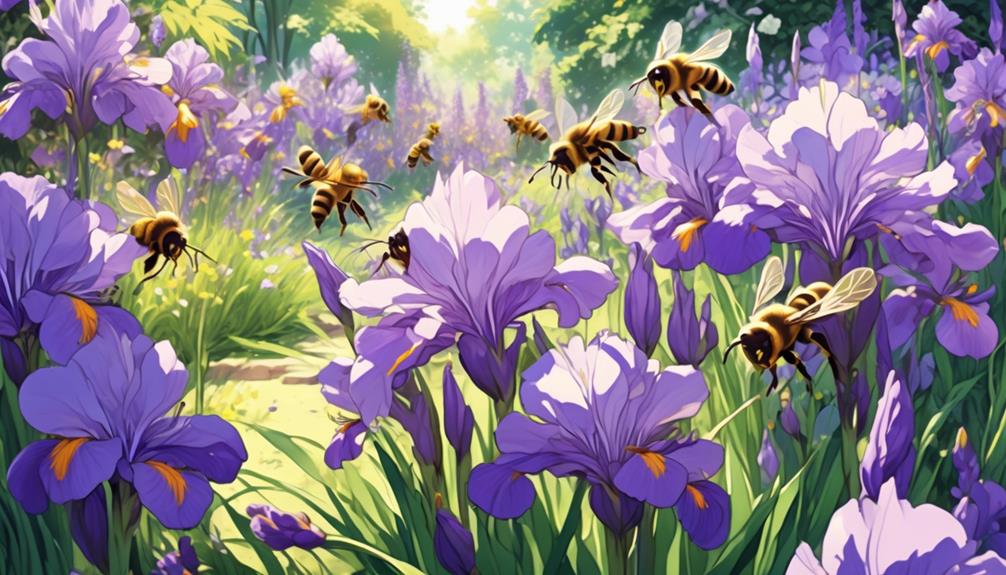
When you observe bees interacting with iris flowers, you'll notice a fascinating dance of nature that reveals the intricate relationship between these insects and their floral partners. The bees, drawn by the iris's vivid colors and sweet nectar, land on the flower's petals and begin their work. Their activity is purposeful, methodical, and significant for both parties involved.
You'll see bees gathering nectar from the iris, a rich source of energy. As they forage, they inadvertently pick up pollen on their furry bodies. This pollen, which is crucial for plant reproduction, is then transferred to the next iris flower the bee visits. This process, known as pollination, helps the iris to produce seeds and reproduce.
Moreover, the structure of the iris flower, with its wide petals and exposed nectar, makes it particularly attractive for bees. It's as if the flower has evolved to cater to the bees' needs, ensuring its own survival.
Impact on Bee Populations
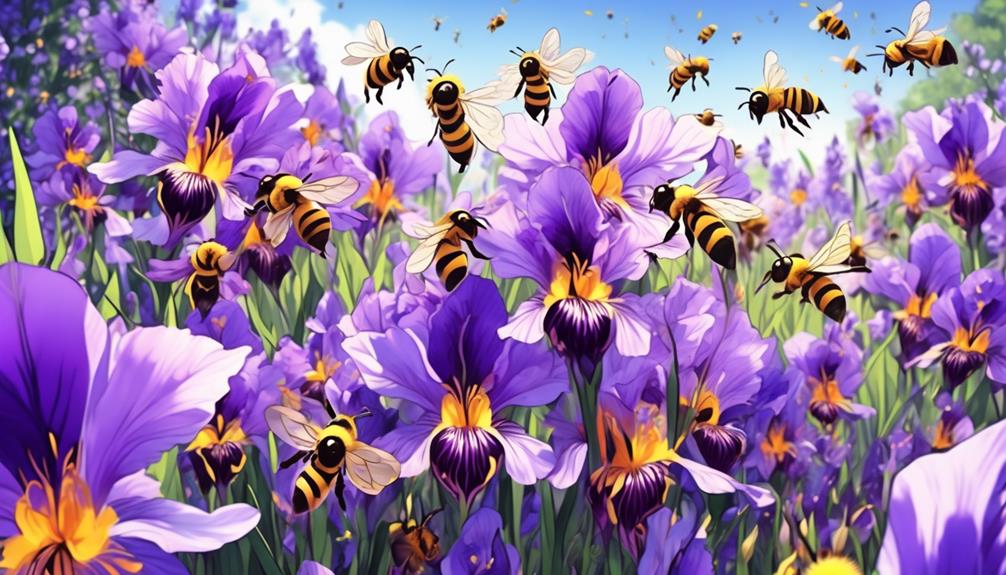
The symbiotic dance between bees and iris flowers, intriguing as it may be, also plays a critical role in the health and survival of bee populations around the world. You see, irises, with their striking colors and unique form, are a veritable buffet for bees, offering both nectar and pollen. These resources are vital for bees, providing them with the necessary energy and protein to thrive.
But it's not just about survival. The relationship between bees and irises also significantly impacts the reproduction and genetic diversity of bee populations. As bees forage on irises, they inadvertently pick up pollen. This pollen gets transferred from flower to flower, enabling cross-pollination. This genetic exchange fosters healthier, more resilient bee populations.
However, it's a delicate balance. Changes to iris populations, whether through habitat loss or climate change, can have cascading effects on bees. If irises decline, bees lose a critical food source and mating site, potentially leading to population declines.
Therefore, it's imperative to conserve both irises and their pollinators, ensuring the continued performance of this vital ecological dance.
Encouraging Bees to Your Garden
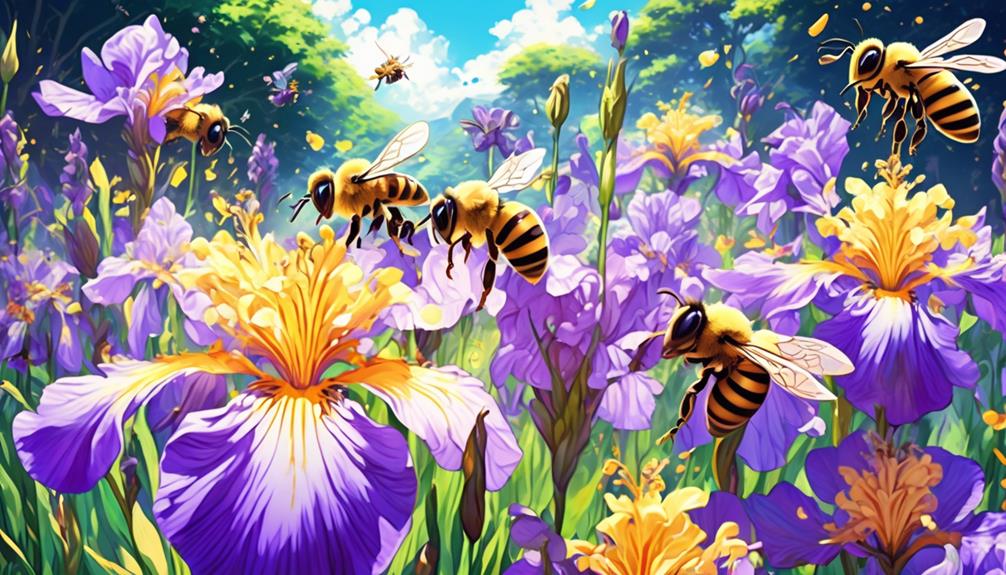
Understanding the crucial relationship between bees and irises, you might be inspired to attract these buzzing pollinators to your own garden. But how can you make your garden more inviting to bees? It's not as complex as you might think.
Firstly, plant a variety of flowering plants, including irises, that bloom at different times of the year. This ensures a consistent food supply for bees. Secondly, avoid using pesticides which can harm bees. Instead, opt for organic gardening methods.
Here's a handy table to guide you on some bee-friendly plants and their blooming periods:
Bee-friendly Plants | Blooming Period |
|---|---|
Irises | Spring |
Lavender | Summer |
Goldenrod | Fall |
Witch Hazel | Winter |
Snowdrops | Early Spring |
Additionally, providing a shallow water source with pebbles for landing can help. Bees need water just like any other living creature.
Lastly, leaving some areas of your garden undisturbed can provide shelter for ground-nesting bees. By implementing these strategies, you're not just enhancing your garden, but also contributing to bee conservation.
Frequently Asked Questions
Are There Specific Species of Bees That Prefer Iris Flowers Over Others?"
Indeed, certain species of bees have a preference for iris flowers. For instance, the mining bees (Andrena) are often attracted to irises. They're drawn to the shape and color of the flower, as well as the nectar and pollen it offers.
However, it's important to note that bees' preferences can vary based on their specific needs and the availability of other flowers in their environment.
Do the Color and Size of the Iris Flower Influence Bees' Attraction to It?"
Yes, the color and size of flowers, including irises, can influence bee attraction. Bees are particularly drawn to blue, purple, and yellow flowers. Larger flowers also tend to attract more bees as they're visible from a distance.
However, it's not just color and size that matter. The scent, shape, and nectar availability of the flower also play key roles in attracting bees.
Can the Cultivation of Iris Flowers in My Garden Harm the Local Bee Population?"
Cultivating iris flowers in your garden won't harm the local bee population. On the contrary, it can actually benefit them. Bees are attracted to irises' vibrant colors and distinct fragrances. They're a great source of nectar and pollen, essential food sources for bees.
What Are Other Flowers That Bees Are Attracted to Similar to Iris Flowers?"
You're wondering about other flowers that attract bees, similar to irises. Bees are drawn to a variety of flowers, such as lavender, sunflowers, and coneflowers. They're also keen on flowering herbs like rosemary and thyme.
These plants not only provide nectar for bees, they also add beauty to your garden. It's beneficial to plant a mix to ensure bees have a food source throughout the year.
How Does the Climate or Season Affect Bees' Preference for Iris Flowers?"
Climate and season significantly impact a bee's preference for certain flowers. You'll find in colder months, bees mightn't favor iris flowers as much, as their nectar production decreases. Conversely, warmer seasons increase nectar production, making irises more attractive to bees.
Conclusion
Indeed, iris flowers can be a bee's paradise. They offer a rich source of nectar and pollen, crucial for a bee's diet.
Your garden will benefit from the bees' pollination, aiding in the growth of your plants.
By planting iris flowers, you're not just beautifying your space, you're also contributing to the survival and growth of bee populations.
So, if you're looking to attract bees, iris flowers could be the perfect choice.

